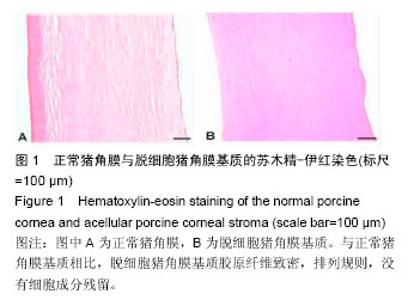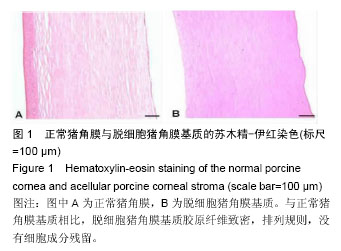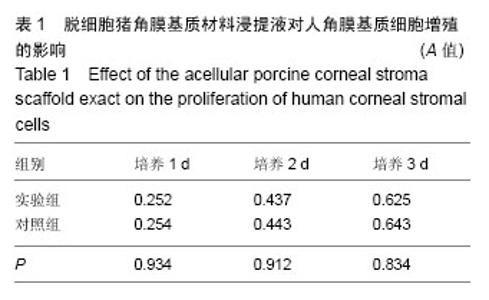Chinese Journal of Tissue Engineering Research ›› 2016, Vol. 20 ›› Issue (30): 4449-4455.doi: 10.3969/j.issn.2095-4344.2016.30.006
Previous Articles Next Articles
Preparation of an acellular porcine corneal stroma scaffold and its biocompatibility
Huo Yin-ping, Zhou Li-xiao, Sun Cheng-lin
- Department of Ophthalmology, the Fifth Affiliated Hospital of Zhengzhou University, Zhengzhou 450052, Henan Province, China
-
Received:2016-04-27Online:2016-07-15Published:2016-07-15 -
Contact:Zhou Li-xiao, M.D., Chief physician, Department of Ophthalmology, the Fifth Affiliated Hospital of Zhengzhou University, Zhengzhou 450052, Henan Province, China -
About author:Huo Yin-ping, Master, Attending physician, Department of Ophthalmology, the Fifth Affiliated Hospital of Zhengzhou University, Zhengzhou 450052, Henan Province, China -
Supported by:the Medical Science and Technology Research Project of Henan, No. 201503131
CLC Number:
Cite this article
Huo Yin-ping, Zhou Li-xiao, Sun Cheng-lin. Preparation of an acellular porcine corneal stroma scaffold and its biocompatibility[J]. Chinese Journal of Tissue Engineering Research, 2016, 20(30): 4449-4455.
share this article
| [1] 王斌,李长兵.深板层角膜移植治疗角膜病的临床观察[J].国际眼科杂志,2012,12(12):2394-2395. [2] 廖聪玲.应用国外捐献的供体角膜组织行穿透性角膜移植的前瞻性研究[D].大连医科大学,2013. [3] Tahvildari M,Omoto M,Chen Y,et al.In Vivo Expansion of Regulatory T Cells by Low-Dose Interleukin-2 Treatment Increases Allograft Survival in Corneal Transplantation.Transplantation. 2016; 100(3):525-532. [4] 徐彬. 组织工程人角膜上皮的体外重建、鉴定及其在新西兰兔角膜上皮移植中的作用研究[D].中国海洋大学, 2012. [5] 陈根云,陈桂强.组织工程角膜内皮载体材料的研究进展[J].中国组织工程研究与临床康复, 2008,12(6):1093- 1096. [6] Szabó DJ,Noer A,Nagymihály R,et al.Long-Term Cultures of Human Cornea Limbal Explants Form 3D Structures Ex Vivo - Implications forTissue Engineering and Clinical Applications.PLoS One. 2015;10(11): e0143053. [7] 随蓓蓓.胶原蛋白复合支架的制备及其与人角膜基质细胞的生物相容性研究[D].中国海洋大学,2013. [8] Salim S, Ariani MD.In vitro and in vivo evaluation of carbonate apatite-collagen scaffolds with some cytokines for bonetissue engineering.J Indian Prosthodont Soc. 2015;15(4):349-355. [9] 隋鲜鲜.甲壳素载体支架的生物相容性和对角膜上皮损伤的修复研究[D].中国海洋大学,2013. [10] Pircher N,Fischhuber D,Carbajal L,et al.Preparation and Reinforcement of Dual-Porous Biocompatible Cellulose Scaffolds for Tissue Engineering. Macromol Mater Eng.2015;300(9):911-924. [11] Feizi S,Montahai T,Moein H.Graft Biomechanics Following Three Corneal Transplantation Techniques.J Ophthalmic Vis Res.2015;10(3):238-242. [12] 梁长森.角膜移植术后不同内皮型免疫排斥反应的活体共聚焦显微镜观察[D].济南大学,2013. [13] 杨贲.76例角膜病行部分穿透性角膜移植术的临床分析[D].吉林大学,2009. [14] Hos D,Dörrie J,Schaft N,et al.Blockade of CCR7 leads to decreased dendritic cell migration to draining lymph nodes and promotes graft survival in low-risk corneal transplantation.Exp Eye Res.2015;146:1-6. [15] Gain P,Jullienne R,He Z,et al.Global Survey of Corneal Transplantation and Eye Banking.JAMA Ophthalmol. 2016;134(2):167-173. [16] 魏君.104例角膜病行穿透性角膜移植术后排斥反应的临床病例分析[D].吉林大学,2010. [17] Miotto M,Gouveia RM,Connon CJ.Peptide Amphiphiles in Corneal Tissue Engineering.J Funct Biomater.2015;6(3):687-707. [18] 李善义,陈建苏.组织工程角膜内皮层移植的研究与应用[J].中国组织工程研究,2013,17(2):363-368. [19] Levis HJ,Kureshi AK,Massie I,Tissue Engineering the Cornea: The Evolution of RAFT.J Funct Biomater. 2015;6(1):50-65. [20] 尹澜,皮裕琍,郭青,等.组织工程角膜联合羊膜移植治疗眼表烧伤疗效观察[J].人民军医, 2013,64(5):548- 550. [21] Lachaud CC,Soria F,Escacena N,et al.Erratum. Mesothelial Cells: A Cellular Surrogate for Tissue Engineering of Corneal Endothelium.Invest Ophthalmol Vis Sci. 2015;56(3):1679. [22] 樊廷俊,刁金美.组织工程人角膜内皮的研究进展[J].山东大学学报(理学版),2014,64(1):1-7. [23] 刘多静,刘长勇,徐圆圆,等.胶原支架在组织工程角膜中的研究进展[J].生物医学工程与临床, 2014,18(3):291- 295. [24] Vázquez N,Chacón M,Meana Á,et al.Keratin-chitosan membranes as scaffold for tissue engineering of human cornea.Histol Histopathol. 2015;30(7):813-821. [25] 周庆军,谢立信.组织工程角膜的基础研究和临床应用现状[J].中华细胞与干细胞杂志(电子版), 2014,4(1): 1-4. [26] 马群.壳聚糖基角膜内皮组织工程载体支架的制备及性能评价[D].中国海洋大学,2010. [27] 李强,孙正义.软骨组织工程支架材料研究的现状[J].中国组织工程研究与临床康复,2007,11(1):133-136. [28] Markovic M,Van Hoorick J,Hölzl K,et al.Hybrid Tissue Engineering Scaffolds by Combination of Three-Dimensional Printing and Cell Photoencapsulation. J Nanotechnol Eng Med. 2015; 6(2):0210011-210017. [29] 随蓓蓓.组织工程载体支架材料研究进展[J].科协论坛(下半月),2013,28(5):52-53. [30] Kim IG,Ko J,Lee HR,et al.Mesenchymal cells condensation-inducible mesh scaffolds for cartilage tissue engineering.Biomaterials.2016;85:18-29. [31] 隋鲜鲜,韩宝芹,刘万顺,等.组织工程甲壳素载体支架对角膜上皮损伤修复作用的研究[J].功能材料, 2013,16: 2313-2319. [32] 鞠成群.脱细胞角膜基质联合内皮样细胞构建生物工程角膜后板层的实验研究[D].山东大学,2012. [33] Ma XY, Zhang Y, Zhu D,et al.Corneal Stroma Regeneration with Acellular Corneal Stroma Sheets and Keratocytes in a Rabbit Model.PLoS One.2015; 10(7):e0132705. [34] 朱婧.胚胎干细胞源角膜缘干细胞联合脱细胞角膜缘基质修复眼表的研究[D].山东大学,2013. [35] 苗莹.基于脱细胞猪角膜基质的组织工程人角膜基质的体外重建及其动物移植研究[D].中国海洋大学,2013. [36] Feng Y,Wang W.In vivo confocal microscopic observation of lamellar corneal transplantation in the rabbit using xenogenic acellular corneal scaffolds as a substitute.Chin Med J (Engl).2015;128(7):933-940. [37] Alio del Barrio JL,Chiesa M,Garagorri N,et al.Acellular human corneal matrix sheets seeded with human adipose-derived mesenchymal stem cells integrate functionally in an experimental animal model.Exp Eye Res.2015;132:91-100. [38] 庞鵾鹏.以异种脱细胞角膜基质构建组织工程兔角膜前板层的实验研究[D].山东大学,2011. [39] 张菊.以脱细胞猪角膜基质为支架体外培养人角膜上皮细胞与成纤维细胞的实验研究[D].山东大学,2015. [40] Zhu J,Zhang K,Sun Y,et al.Reconstruction of functional ocular surface by acellular porcine cornea matrix scaffold and limbal stem cells derived from human embryonic stem cells.Tissue Eng Part A.2013; 19(21-22):2412-2425. [41] 汲婧,刘子源,张晶,等.脱细胞真皮基质在角膜中植入性的生物力学研究[J].力学学报,2014,46(1):145-154. [42] Liu XN,Zhu XP,Wu J,et al.Acellular ostrich corneal stroma used as scaffold for construction of tissue-engineered cornea.Int J Ophthalmol. 2016;9(3): 325-331. [43] Zhang J,Zhang CW,Du LQ,et al.Acellular porcine corneal matrix as a carrier scaffold for cultivating human corneal epithelial cells and fibroblasts in vitro. Int J Ophthalmol.2016;9(1):1-8. [44] Xue C,Xia Y,Chen Y,et al.Treatment of large corneal perforations with acellular multilayer of corneal stromal lenticules harvested from femtosecond laser lenticule extraction.Zhonghua Yan Ke Za Zhi. 2015;51(9): 655-659. [45] Shao Y,Tang J,Zhou Y,et al.A novel method in preparation of acellularporcine corneal stroma tissue for lamellar keratoplasty.Am J Transl Res. 2015;7(12): 2612-2629. [46] Wee SW,Choi SU,Kim JC.Deep anterior lamellar keratoplasty using irradiated acellular cornea with amniotic membrane transplantation for intractable ocular surface diseases.Korean J Ophthalmol. 2015; 29(2):79-85. [47] Alio del Barrio JL,Chiesa M Garagorri N,et al.Acellular human corneal matrix sheets seeded with human adipose-derived mesenchymal stem cells integrate functionally in an experimental animal model.Exp Eye Res. 2015;132:91-100. [48] Diao JM,Pang X,Qiu Y,et al.Construction of a human corneal stromal equivalent with non-transfected human corneal stromal cells and acellular porcine corneal stromata.Exp Eye Res.2015;132:216-224. [49] Liu Z,Zhou Q,Zhu J,et al.Using genipin-crosslinked acellular porcine corneal stroma for cosmetic corneal lens implants.Biomaterials.2012;33(30):7336-7346. [50] Hahn N,Dietz CT,Kühl S,et al.KLEIP deficiency in mice causes progressive corneal neovascular dystrophy.Invest Ophthalmol Vis Sci. 2012;53(6): 3260-3268. |
| [1] | Zhang Tongtong, Wang Zhonghua, Wen Jie, Song Yuxin, Liu Lin. Application of three-dimensional printing model in surgical resection and reconstruction of cervical tumor [J]. Chinese Journal of Tissue Engineering Research, 2021, 25(9): 1335-1339. |
| [2] | Zeng Yanhua, Hao Yanlei. In vitro culture and purification of Schwann cells: a systematic review [J]. Chinese Journal of Tissue Engineering Research, 2021, 25(7): 1135-1141. |
| [3] | Xu Dongzi, Zhang Ting, Ouyang Zhaolian. The global competitive situation of cardiac tissue engineering based on patent analysis [J]. Chinese Journal of Tissue Engineering Research, 2021, 25(5): 807-812. |
| [4] | Wu Zijian, Hu Zhaoduan, Xie Youqiong, Wang Feng, Li Jia, Li Bocun, Cai Guowei, Peng Rui. Three-dimensional printing technology and bone tissue engineering research: literature metrology and visual analysis of research hotspots [J]. Chinese Journal of Tissue Engineering Research, 2021, 25(4): 564-569. |
| [5] | Chang Wenliao, Zhao Jie, Sun Xiaoliang, Wang Kun, Wu Guofeng, Zhou Jian, Li Shuxiang, Sun Han. Material selection, theoretical design and biomimetic function of artificial periosteum [J]. Chinese Journal of Tissue Engineering Research, 2021, 25(4): 600-606. |
| [6] | Liu Fei, Cui Yutao, Liu He. Advantages and problems of local antibiotic delivery system in the treatment of osteomyelitis [J]. Chinese Journal of Tissue Engineering Research, 2021, 25(4): 614-620. |
| [7] | Li Xiaozhuang, Duan Hao, Wang Weizhou, Tang Zhihong, Wang Yanghao, He Fei. Application of bone tissue engineering materials in the treatment of bone defect diseases in vivo [J]. Chinese Journal of Tissue Engineering Research, 2021, 25(4): 626-631. |
| [8] | Zhang Zhenkun, Li Zhe, Li Ya, Wang Yingying, Wang Yaping, Zhou Xinkui, Ma Shanshan, Guan Fangxia. Application of alginate based hydrogels/dressings in wound healing: sustained, dynamic and sequential release [J]. Chinese Journal of Tissue Engineering Research, 2021, 25(4): 638-643. |
| [9] | Chen Jiana, Qiu Yanling, Nie Minhai, Liu Xuqian. Tissue engineering scaffolds in repairing oral and maxillofacial soft tissue defects [J]. Chinese Journal of Tissue Engineering Research, 2021, 25(4): 644-650. |
| [10] | Xing Hao, Zhang Yonghong, Wang Dong. Advantages and disadvantages of repairing large-segment bone defect [J]. Chinese Journal of Tissue Engineering Research, 2021, 25(3): 426-430. |
| [11] | Chen Siqi, Xian Debin, Xu Rongsheng, Qin Zhongjie, Zhang Lei, Xia Delin. Effects of bone marrow mesenchymal stem cells and human umbilical vein endothelial cells combined with hydroxyapatite-tricalcium phosphate scaffolds on early angiogenesis in skull defect repair in rats [J]. Chinese Journal of Tissue Engineering Research, 2021, 25(22): 3458-3465. |
| [12] | Wang Hao, Chen Mingxue, Li Junkang, Luo Xujiang, Peng Liqing, Li Huo, Huang Bo, Tian Guangzhao, Liu Shuyun, Sui Xiang, Huang Jingxiang, Guo Quanyi, Lu Xiaobo. Decellularized porcine skin matrix for tissue-engineered meniscus scaffold [J]. Chinese Journal of Tissue Engineering Research, 2021, 25(22): 3473-3478. |
| [13] | Mo Jianling, He Shaoru, Feng Bowen, Jian Minqiao, Zhang Xiaohui, Liu Caisheng, Liang Yijing, Liu Yumei, Chen Liang, Zhou Haiyu, Liu Yanhui. Forming prevascularized cell sheets and the expression of angiogenesis-related factors [J]. Chinese Journal of Tissue Engineering Research, 2021, 25(22): 3479-3486. |
| [14] | Liu Chang, Li Datong, Liu Yuan, Kong Lingbo, Guo Rui, Yang Lixue, Hao Dingjun, He Baorong. Poor efficacy after vertebral augmentation surgery of acute symptomatic thoracolumbar osteoporotic compression fracture: relationship with bone cement, bone mineral density, and adjacent fractures [J]. Chinese Journal of Tissue Engineering Research, 2021, 25(22): 3510-3516. |
| [15] | Liu Liyong, Zhou Lei. Research and development status and development trend of hydrogel in tissue engineering based on patent information [J]. Chinese Journal of Tissue Engineering Research, 2021, 25(22): 3527-3533. |
| Viewed | ||||||
|
Full text |
|
|||||
|
Abstract |
|
|||||









